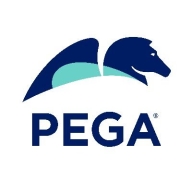

Pega Platform and Apache Airflow are notable competitors in the field of enterprise automation and data orchestration. Pega Platform stands out in enterprise-level implementation due to its strong case management and integration capabilities, while Apache Airflow is recognized for its flexibility and ease of use in Python scripting, making it a favorite for open-source projects and data science workflows.
Features: Pega Platform provides rapid implementation, cloud integration, and a robust case management system, making it ideal for large enterprises. Its visual interface aids in usability and allows for quick adaptation to complex processes. Apache Airflow is valued for its Python-based configuration, ideal for data science tasks, and offers broad customization thanks to its open-source nature, appealing to users needing extensive workflow orchestration.
Room for Improvement: Pega Platform is often criticized for its high costs, steep learning curve, and complex upgrade process. Users seek better integration capabilities and smoother cloud options. Apache Airflow requires enhancements in technical support, integration with non-Python systems, and improved UI and real-time processing capabilities to better serve detailed workflow demands.
Ease of Deployment and Customer Service: Pega Platform suits enterprises requiring on-premises to hybrid deployments with strong system integration, though its support efficiency can vary. The accompanying community offers valuable self-service resources. Apache Airflow excels with its straightforward setup in public cloud environments like AWS and benefits from strong community support, though technical assistance responsiveness could be improved.
Pricing and ROI: Pega Platform's pricing, based on users or use cases, caters to large-scale operations, offering substantial ROI despite high costs. Apache Airflow, being open-source, avoids licensing fees, making it a cost-effective option for DIY data orchestration, though operational costs due to infrastructure needs can impact ROI depending on deployment scale.
Forums and community resources like Stack Overflow are helpful.
There is enough documentation available, and the community support is good.
The technical support from Pega is very low, rating a one or two out of ten.
I never needed support from the platform standpoint, but if additional features are required, we have regular meetings with the product team for feedback.
Pega's technical support team is very helpful.
Apache Airflow scales well, especially when deployed in Kubernetes environments.
The solution is very scalable.
Currently, big banking providers and insurance providers, even the members for healthcare payers, are using more than millions of operations on a daily or weekly basis.
I would rate the stability of the solution as ten out of ten.
I would rate its stability at nine out of ten.
Apache Airflow is stable and I have not experienced significant issues.
It is not suitable for real-time ETL tasks.
There is no dashboard for us to check all the Directed Acyclic Graphs (DAGs); a dashboard would help us analyze the work better.
If we desire to add custom messengers or a rest API, those options are unavailable.
For customer interactions, while the Pega Platform's AI-based decisioning and predictive analytics are great, the Process AI is not very popular yet, as it works on process data rather than customer data.
Pega introduced Constellation, which allows a user to build a more engaging visual experience.
My learning curve in robotics has been challenging.
I prefer using the open-source version rather than the enterprise version, which helps manage costs.
It is a sub-feature and not an individual purchase.
Apache Airflow is a community-based platform and is not a licensed product.
From a licensing perspective, it is higher than the competition.
Pega is priced higher than open-source options like Flowable but is suitable for large-scale industries like banking and insurance.
The pricing is expensive, and this is an issue.
Reliability is good, and when integrated with Kubernetes, it performs better compared to on-premises environments.
Apache Airflow is an open-source platform that allows easy integration with AWS, Azure, and Google Cloud Platform.
We can create notifications for successful or failed tasks, providing a practical way to monitor our workflows.
Pega Platform is excellent for enterprise-level solutions with integrations to entire systems, including case management, service orchestration, CRM, decision-making capabilities, digital process automation, and AI-driven functionalities.
Management capabilities such as dashboards.
| Product | Market Share (%) |
|---|---|
| Apache Airflow | 5.5% |
| Pega Platform | 5.2% |
| Other | 89.3% |


| Company Size | Count |
|---|---|
| Small Business | 13 |
| Midsize Enterprise | 3 |
| Large Enterprise | 24 |
| Company Size | Count |
|---|---|
| Small Business | 9 |
| Midsize Enterprise | 15 |
| Large Enterprise | 68 |
Apache Airflow is an open-source workflow management system (WMS) that is primarily used to programmatically author, orchestrate, schedule, and monitor data pipelines as well as workflows. The solution makes it possible for you to manage your data pipelines by authoring workflows as directed acyclic graphs (DAGs) of tasks. By using Apache Airflow, you can orchestrate data pipelines over object stores and data warehouses, run workflows that are not data-related, and can also create and manage scripted data pipelines as code (Python).
Apache Airflow Features
Apache Airflow has many valuable key features. Some of the most useful ones include:
Apache Airflow Benefits
There are many benefits to implementing Apache Airflow. Some of the biggest advantages the solution offers include:
Reviews from Real Users
Below are some reviews and helpful feedback written by PeerSpot users currently using the Apache Airflow solution.
A Senior Solutions Architect/Software Architect says, “The product integrates well with other pipelines and solutions. The ease of building different processes is very valuable to us. The difference between Kafka and Airflow, is that it's better for dealing with the specific flows that we want to do some transformation. It's very easy to create flows.”
An Assistant Manager at a comms service provider mentions, “The best part of Airflow is its direct support for Python, especially because Python is so important for data science, engineering, and design. This makes the programmatic aspect of our work easy for us, and it means we can automate a lot.”
A Senior Software Engineer at a pharma/biotech company comments that he likes Apache Airflow because it is “Feature rich, open-source, and good for building data pipelines.”
Pega Platform provides flexible business process management with a focus on rapid application development and automation through a low-code approach, enhancing efficiency across sectors.
Pega Platform is renowned for its ability to streamline operations with robust automation features, including robotic process automation and decision-making capabilities. Its intuitive interface and workflow management contribute to a reputation for enhancing business processes. Although users face challenges with integration limitations and high licensing costs, they benefit from rapid deployment and efficient process adaptations. The unified architecture reduces complexity, while case management and integration services support digital transformations in sectors such as banking, insurance, and healthcare.
What are the key features of Pega Platform?In industries like insurance, banking, healthcare, and government, Pega Platform is implemented to automate diverse workflows, supporting initiatives from claims processing to customer onboarding. Enterprises use Pega for case management and digital transformations, valuing its out-of-the-box integrations and real-time reporting capabilities to boost operational automation and enhance customer experiences.
We monitor all Business Process Management (BPM) reviews to prevent fraudulent reviews and keep review quality high. We do not post reviews by company employees or direct competitors. We validate each review for authenticity via cross-reference with LinkedIn, and personal follow-up with the reviewer when necessary.